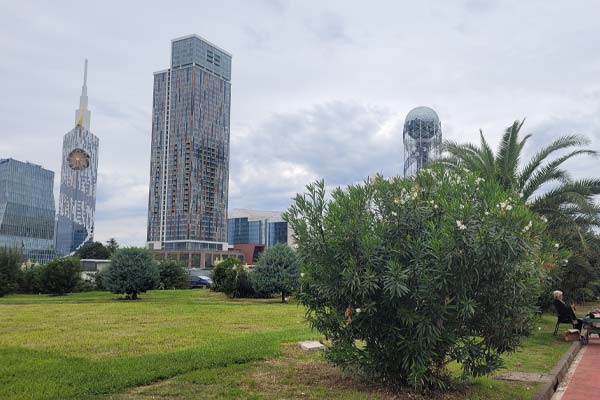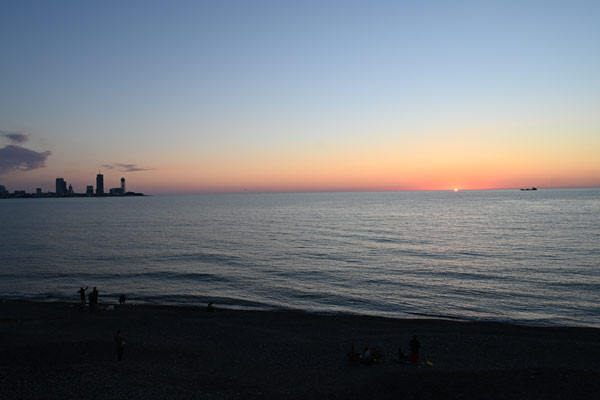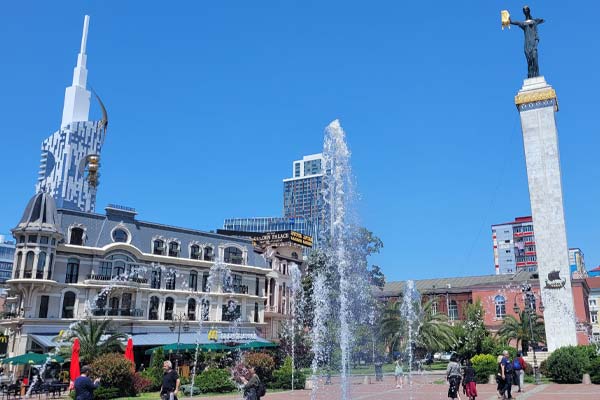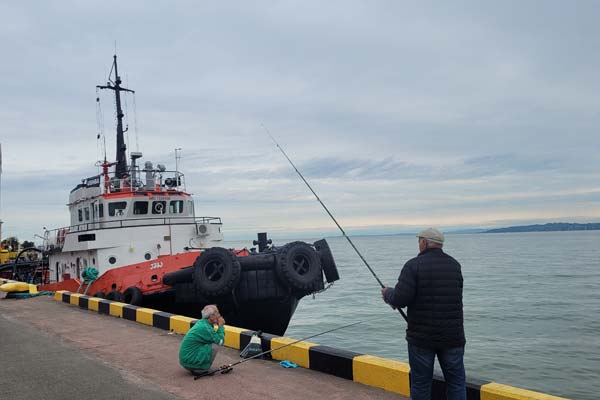|
Adjara Adjara, on the Black Sea coast, is one of the most beautiful and richest regions of Georgia. Almost everything grows in Adjara, from citrus fruits and teas to pomegranates and figs. In addition to agriculture, the region has the country's largest port, several spas, a ski resort and very beautiful beaches. Ajaria is also a region of contrasts. There are villages where people live as they did centuries ago, without electricity, gas, roads or running water, with their cattle in one house. At the same time, there are modern towns with skyscrapers, 5-star hotels and casinos that look like Las Vegas in the USA. Ajaria is also a good example of people of different religions living together, as about 35% of the population are Muslims, about 5% are Catholics and the majority are Orthodox Christians. Everyone lives peacefully together and can freely practice their own religion. General info Area: 2,900 km2 The name Adjara is first mentioned with the Georgian name Adjara in a written document from the 11th century. Some scholars identify the name with the territory of historical Chaneti, most of which is now in Turkey. Why is Adjara an autonomous republic? In 1921, after the Treaty of Kars, a treaty was signed between the Transcaucasian Soviet Federative Socialist Republics (Georgia, Armenia, Azerbaijan) and Turkey, and the borders were redrawn. In Adjara, Muslim Georgians made up the majority of the population, so it was agreed in 1921 that the region would be granted autonomous status. Cultural and natural highlights Adjara is best known for its diverse nature, spas, national parks and beaches on the Black Sea coast, but there are also several fortresses and castles dating from the Roman period, as well as medieval arched bridges, churches and monasteries. Natural highlights 1. Kobuleti National Park Cultural monuments 1. Gonio Fortress Spas and resorts 1. Batumi Traditions and festivals in Adjara Traditions in Adjaria are neither purely Christian nor Muslim, they are relatively neutral, so they are celebrated by both denominations. The most common folk festival in Adjaria is Schuamtoba. It is celebrated at the beginning of August, when the summer or grazing season is half over. The inhabitants of the valley load their cars (formerly horse carts) with all kinds of fruit and vegetables and drive to their relatives, friends and family members in the Ajarian mountains. There they are awaited with all kinds of dairy and meat products and they organise a concert, various competitions such as Wrestling, arm wrestling, horse races, etc. The newlyweds receive symbolic gifts from the president of the regional parliament, and a festive feast is held at the end. Wedding ritual in Adjara During the wedding, no matter how big, the bride's parents put together 5 baskets of sweets and take them to the newlyweds. The wedding gift is called "sadili" and, apart from sweets, includes a certain amount of money and, in the best case, an additional gift of money. If the bride's family is not financially able to make the sadili, it is made up for later, and if this is not possible, it is mentioned in the will that the next generation should make up for the parents' debt. This wedding tradition is thought to have spread to Adjara from the 16th century onwards, after the region was converted to Islam by the Ottomans, but is now observed by everyone in the region, regardless of religion. The cuisine of Adjara Adjara is a good example of how dairy products can be used to make a wide variety of dishes that look and taste very different. These dishes are not for the calorie-conscious, but they are definitely worth a sin or two. Most of the specialities are made only in Adjara and are rarely found in other regions, so if you want to try Adjara dishes, you have to travel to the region. It is interesting to know that the local dish "borano" has been included in the list of intangible cultural heritage of Georgia in 2019. 1. Acharuli Khachapuri - Georgian flat bread in the shape of a boat, filled with melted cheese and a fried egg in the middle. 2. Atschma - Georgian version of lasagne, but with cheese instead of meat. 3. Borano - soft homemade cheese mixed with melted hot butter. 4. Yakhni from Kobuleti - There are several dishes with the same name in the world, especially in Turkey, Greece and Asian countries, but Yakhni from Acharia and especially from Kobuleti is something completely different. It is made from beef breast walnut paste, garlic, coriander, saffron and onion. 5. Chirbuli - is made from eggs, tomatoes, walnuts and various fresh herbs. 6. Sinori - Small sliced pita bread with melted butter and soft cheese. 7. Kaymak - In Ajaria this dish was introduced from Turkey, but is also prepared in Iraq, Bulgaria, Serbia and other countries. It is a layered cream and is compared to English clotted cream. 8. malachto - green beans mixed with fresh herbs in sour grape juice. History of Adjara Adjara is one of the oldest regions of Georgia, which, along with Meskheti, was part of the Kingdom of Kartli in pre-Christian times. The legend of the Argonauts is also associated with the region. The Christian religion is also said to have spread from Ajaria to Georgia as early as the 1st century, through Andrew, the first apostle called Matthias. However, the name Ajaria does not appear until the 11th century, as a principality subordinate to the neighboring Grand Duchy of Meskheti and both as part of the Kingdom of Georgia. In the following centuries, Adjara was part of Georgia, but under the rule of the neighboring Grand Principalities of Meskheti and Guria. In the mid-16th century, when Georgia broke up into several kingdoms, the Ottomans managed to annex Adjara for the next 300 years or so and largely Islamised the region, but the inhabitants still managed to preserve the Georgian language and culture for several centuries. During the Russo-Ottoman War of 1828-29, in which Georgians were heavily involved, one of the main front lines passed through Adjara and some of the region's inhabitants fought on the Georgian-Russian side. After the Ottoman defeat, Adjara became part of Georgia again, but during the Chaotic. After the negotiation of the treaty and the mistranslation, the border was not drawn at the end of the region, at the river Chorochi, but right at the beginning, at the river Chorochi. Ajaria thus remained in Ottoman hands for another 50 years. After the next and last war between the Ottomans and the Russian Empire in 1877-1878, Georgia regained its historical territories, including Adjara, but during the First World War the Turks again tried to take over old Ottoman territories. To prevent Ottoman expansion, German troops landed in the region's capital, Batumi. After the Central Powers lost the war, the German troops were replaced by British soldiers in 1918. In 1921, after Ajaria and other parts of Georgia were occupied by the Bolsheviks, Ajaria and the whole of Georgia were incorporated into the Soviet Union. Adjara after Georgia's independence After independence in 1991, Aslan Abashidze, a former deputy minister for supply territories, came to power in the autonomous republic. His family had historically played a leading role in the region during the Ottoman period. His family, and in particular his grandfather, Memed Abashidze, played an important role in the liberation of Ajaria from the Ottomans. In any case, his family's ties to Turkey and Russia certainly helped him to gain power in the region with relative ease. Once in power, Abashidze took advantage of Georgia's troubled times to establish an autocratic regime that was part of Georgia but largely independent. Adjara was ruled by Abashidze and his family as a feudal principality for the next 13 years. Under his rule, Adjara developed its own armed forces and paid no taxes to Georgia. Border controls were introduced by the local police at the Adjarian border and fees were charged. Although Abashidze unofficially made the region an independent republic, he maintained harmonious relations with the then president of Georgia, Eduard Shevardnadze. However, his rule was based less on his relationship with Shevardnadze than on the Russian military bases stationed in Adjara. Change of power in Adjara In 2004, after the new Georgian president, Mikhail Saakashvili, came to power, the situation in Adjara changed. The Georgian parliament demanded Abashidze's resignation, and with no support from Russia, Abashidze was forced to resign and flee to Moscow with his family. Subsequently, the autonomy of Adjaria was not abolished, but it was limited by law. According to the new laws, the Adjarian prime minister is elected on the proposal of the Georgian prime minister (former president), and the decisions of the Adjarian parliament can be suspended by the parliament in Tbilisi. In July 2007, the Georgian Constitutional Court moved its seat from Tbilisi to Batumi as part of the domestic power balance. In the same year, the last Russian soldiers left the region. On following trip, you will visit Adjara from 1.190 EUR
|






